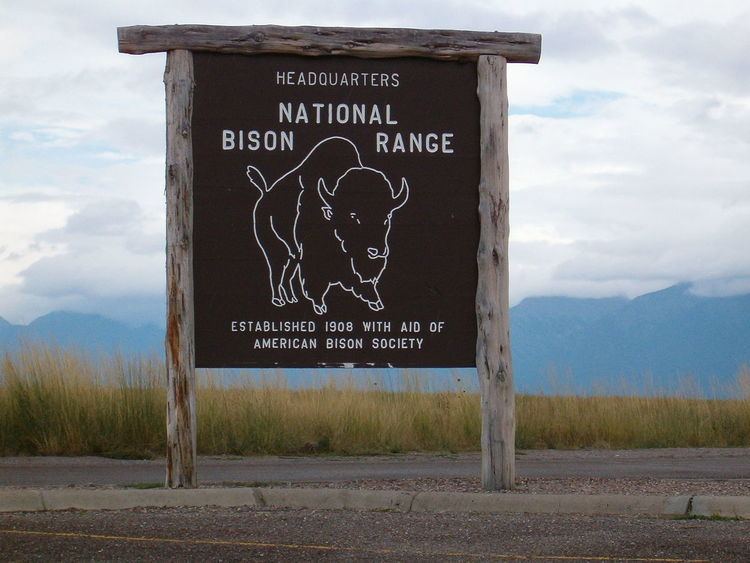Nearest city Missoula, MT Website National Bison Range Phone +1 406-644-2211 | Visitors est. 250,000 (in 2004) Area 76.08 km² Established 1908 | |
 | ||
Location Lake / Sanders counties, Montana, USA Governing body U.S. Fish and Wildlife Service Address 58355 Bison Range Rd, Charlo, MT 59824, USA Management United States Fish and Wildlife Service Similar Mission Mountains, Flathead Lake, Rocky Mountains, Pablo National Wildlife R, St Ignatius Mission Profiles | ||
National bison range montana usa
The National Bison Range (NBR) is a National Wildlife Refuge located in western Montana established in 1908 to provide a sanctuary for the American bison. The NBR is one of the oldest National Wildlife Refuges in the United States. The size of the bison herd at the NBR is relatively small, numbering between 350 and 500 individuals. The initial herd of American bison was provided by organizations such as the American Bison Society, and today the refuge serves as the central point for bison research in the United States.
Contents
The NBR consists of approximately 18,800 acres (7,600 ha) and is managed by the U.S. Fish and Wildlife Service. Other nearby National Wildlife Refuges are managed as parts of the National Bison Range Complex and include the Lost Trail, Ninepipe, Pablo and the Swan River National Wildlife Refuges. Also affiliated is the Northwest Montana Wetland Management District.
The NBR has a visitor center, and two scenic roads that allow vehicular access to prime viewing areas. The refuge is approximately one hour north of Missoula, Montana with signs off of U.S. Highway 93 directing visitors to the entrance at Moiese, Montana, and the refuge headquarters.
Episode 30 national bison range
Geology
The Refuge is essentially a small, low-rolling mountain connected to the Mission Mountain Range by a gradually descending spur. Range elevation varies from 2,585 feet at headquarters to 4,885 feet at High Point on Red Sleep Mountain, the highest point on the Range. Much of the National Bison Range was once under prehistoric Glacial Lake Missoula, which was formed by a glacial ice dam on the Clark Fork River about 13,000 to 18,000 years ago. The lake attained a maximum elevation of 4,200 feet, so the upper part of the Refuge was above water. Old beach lines are still evident on north-facing slopes. Topsoil on the Range is generally shallow and mostly underlain with rock which is exposed in many areas, forming ledges and talus slopes. Soils over the major portion of the Range were developed from materials weathered from strongly folded pre-Cambrian quartzite and argillite bedrock.
Fauna
Once believed to number in the tens of millions, bison once were found in all the current U.S. states, except Hawaii, and also throughout Canada.
Bison were nearly extinct by 1890, having been part of a Federal government sponsored program of eradication during the Indian Wars, thereby removing a vital food source from the Plains Indians diet, and ensuring easier relocation onto Indian reservations.
Bison were also considered to be a less desirable food source than domesticated cattle because of their wild nature. They were also viewed as competition for prime grazing lands that could be used by cattle.
By the beginning of the 20th century efforts were being made to preserve the remaining bison and protect areas in which they could reconstitute. Approximately 250,000 bison can be found on federal and state lands, and in privately owned herds.
Bison have an average of 60% of the fat content per pound of beef and more protein. Most of the private herds are used as a food source. Bison meat is gaining in popularity and often found in grocery stores and restaurants.
In addition to the 350 to 500 bison on the National Bison Range, many other mammal species may be seen on the refuge, including coyote, black bear, elk, mule deer, bighorn sheep, white-tailed deer, pronghorn, mountain cottontail, Columbian ground squirrel, muskrat, yellow-pine chipmunk, badger, and cougar.
Over two hundred bird species have been seen on the refuge.
Flora
The National Bison Range contains many plant species, including the bitterroot, ponderosa pine, and buffalo grass.
